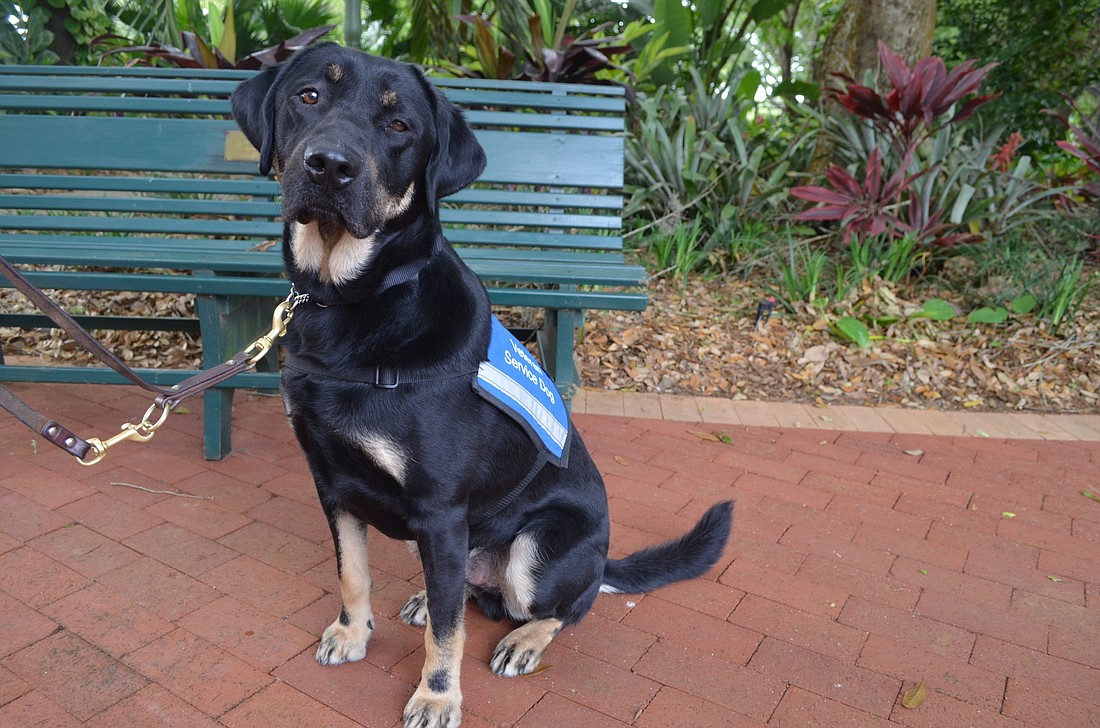- November 24, 2024
-
-
Loading

Loading

Southeastern Guide Dogs has trained more than 2,800 guide-dog teams since its establishment in 1982. Although the nonprofit is best known for its guide dogs — it currently has more than 410 active guide-dog partnerships — some puppies work best in alternative careers, such as therapy dogs, ambassador dogs or public service dogs.
Careers are chosen for dogs based upon a physical and behavioral analysis. The Observer meets the hardworking golden retrievers and Labradors of the nonprofit who lead the way in their respective canine careers.
Facility Therapy Dogs
These dogs are placed in military hospitals and facilities to help wounded veterans heal and spread cheer. Facility therapy dogs are part of Southeastern’s Paws for Patriots Program that includes guide dogs for legally blind veterans and veteran-service dogs.
Veteran-Service Dogs
Veteran-service dogs are paired with a veteran suffering from PTSD. These dogs go through special training to learn commands, such as the hug command, which helps calm an owner’s anxiety.
Canine Connection
Canine connection dogs are placed with a visually impaired child between the ages of 10 and 17 to help prepare the child for a permanent guide dog once her or she turns 18. These dogs need to be comfortable around children of all ages.
Ambassador Dog
These dogs go out in the community as representatives of Southeastern Guide Dogs. They are adopted by a family and do not receive special training other than the basic commands. Ambassador dogs need to be calm and comfortable in any situation. They also need to be especially sweet and gentle. The dogs visit hospitals, make public appearances and visit with children.
Public Service Dog
Police organizations come to Southeastern Guide Dogs for well-behaved puppies. The puppies are immediately turned over to the organizations instead of receiving training at Southeastern Guide Dogs. One of the signs of a good public service dog is a love of sniffing.
Puppy, 5 weeks
Southeastern Guide Dogs prefers to breed its own dogs. The nonprofit breeds Labradors, golden retrievers and a mix of the two, known as “goldador” or “goldador-able.”
Puppies start training as young as 3 days old with light touches. The puppies are not given names until they are older; instead, trainers call them by different colors.
The puppy will stay in the kennel with its litter mates until it is 10 weeks old, then a family will raise it for a little more than a year.
When it returns from the raiser family, the puppy will go through a little more than a year of evaluation and training. Puppies are evaluated by their energy level, the use of mouth (a hard or soft grip), their vocalizations and whether they are hesitant in a new situation. These personality traits help trainers place the puppy in the right career.
VeeZee, 1 1/2 years
In training
VeeZee is in the middle of training and evaluation. VeeZee returned to Southeastern Guide Dogs in January after living with a family in south Florida. Since then, she has had 15 hours of in-harness training and is showing promise.
The Southeastern Guide Dogs campus, located in Palmetto, has 35 acres and will be VeeZee’s home until she is ready to be paired with her new owner. VeeZee works with certified guide-dog trainers, such as Caitlin O’Brien, to learn how to navigate along curbs, railroads and different textured pathways.
VeeZee needs to be able to stay focused at all times and be confident in making decisions for her owner.
Borris, 2 years
Veteran-service dog
Borris has been training to be a service dog for veterans for a little more than four months. (Before he made his career change, Borris was in training to be a guide dog.) Borris will make a good veteran-service dog because he is interactive with his handler, comfortable in many types of environments and easy to manage on a leash.
As a veteran-service dog, Borris will act as stabilizer for his owner. In case his owner doesn’t like stepping into dark rooms, Borris can turn on and off lights. He also knows how to watch his owner’s back and act as a third eye.
One of Borris’ redeeming qualities is his ability to think quickly. When Borris sees that his owner is having a panic attack or is feeling uncomfortable, Borris instinctively puts his weight on his owner and gives him or her kisses. This is known as the “hug command.” Borris’ pressure helps steady his owner’s breathing while the kisses help bring the owner back to the present.
Lindy, 4 years
Ambassador dog
After Lindy was raised by a family as a puppy and brought back to Southeastern Guide Dogs, she was placed in the Ambassador program due to her propensity for hip dysplasia. She has been an ambassador dog since Jim Cliff adopted her at 15 months old. Lindy and Cliff are volunteer ambassadors for Southeastern Guide Dogs, which means they make public appearances to represent the organization.
One of Lindy’s jobs is to give back to the community. One way she does this is by having children read to her. Her unconditional love gives children the confidence to read out loud without worrying about being judged.
Cliff says Lindy’s calm nature has helped him relax. He also says working with Lindy and Southeastern Guide Dogs has been rewarding.
“The mission is so simple, yet it fills such a huge need,” says Cliff.
Cliff and Lindy lead tours at the nonprofit’s campus twice a week and plan on volunteering with Southeastern Guide Dogs for years to come. When she’s not being read to or giving tours, Lindy loves to swim and chase tennis balls.